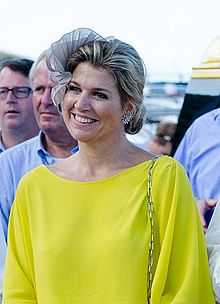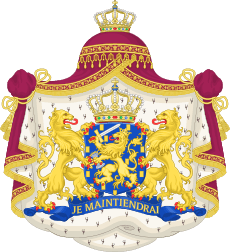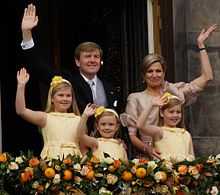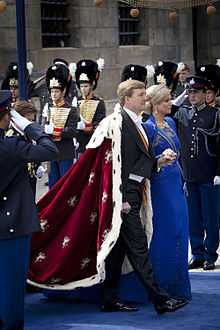Queen Máxima of the Netherlands
| Máxima | |
|---|---|
 Queen Maxima in a Caribbean Tour, 2013 | |
| Queen consort of the Netherlands | |
| Tenure | 30 April 2013 – present |
| Spouse | Willem-Alexander of the Netherlands |
| Issue |
Catharina-Amalia, Princess of Orange Princess Alexia Princess Ariane |
| Father | Jorge Zorreguieta |
| Mother | María del Carmen Cerruti Carricart |
| Born |
17 May 1971 Buenos Aires, Argentina |
| Religion | Roman Catholicism |
| Dutch Royal Family |
|---|
 |
Extended royal family
* Member of the Dutch royal house |
Queen Máxima of the Netherlands (born Máxima Zorreguieta Cerruti[1] on 17 May 1971) is the wife of King Willem-Alexander. On 30 April 2013, she became the first Dutch queen consort since 1890.
Early life and education
Máxima Zorreguieta Cerruti was born in Buenos Aires, Argentina, on 17 May 1971. Queen Máxima is the daughter of Jorge Zorreguieta (born 1928), secretary of agriculture under President Jorge Rafael Videla during the National Reorganization Process dictatorship, and his second wife, María del Carmen Cerruti Carricart (born 1944). She has two brothers, a sister and three half-sisters by her father's first wife, Marta López Gil.[2][3] She is named after her paternal great-grandmother Máxima Bonorino González (1874–1965), whose mother Máxima González y de Islas belonged to the family of Justo José de Urquiza († 1870), the first Constitutional President of Argentina.[4]
She grew up in the Recoleta neighbourhood of Buenos Aires city, and studied at Northlands School, a bilingual school of the city of Olivos. She graduated with a degree in Economics from the Pontifical Catholic University of Argentina in 1995, and later completed her studies with a Master in the United States. She subsequently worked for large international finance companies in Argentina, New York, and Brussels.[5] She also worked as a teacher of English language to children and adults, and of Mathematics for high school students and freshmen.
Through her father, she is a descendant of King Afonso III of Portugal, and other noble families of the Iberian Peninsula.[2][6][7]
Relationship with Willem-Alexander

Máxima met Willem-Alexander in April 1999 in Seville, Spain, during the Seville Spring Fair. In an interview, they stated that he introduced himself only as "Alexander", so that she did not know he was a prince. She thought he was joking when he later told her that he was not only a prince, but the Prince of Orange and heir apparent to the Dutch throne. They agreed to meet again two weeks later in New York, where Máxima was working for Dresdner Kleinwort Benson. Their relationship apparently began in New York, but she did not meet his parents, Queen Beatrix and Prince Claus, for some time.
The news of the couple's relationship and eventual marriage plans caused controversy in the Netherlands, due to the involvement of Máxima's father Jorge Zorreguieta as a cabinet minister during the National Reorganization Process, the latest Argentinian dictatorship. Her father's tenure as a minister took place during the beginning stages of the Dirty War, a period of repression that saw 10,000–30,000 people killed or disappeared during the seven-year military regime. At the request of the States General, Michiel Baud, a Dutch professor in Latin American studies, carried out an inquiry into the involvement of Zorreguieta in the Dirty War. Zorreguieta claimed that, as a civilian, he was unaware of the Dirty War while he was a cabinet minister. Baud determined that Máxima's father had not been directly involved in any of the numerous atrocities that took place during that period. However, Baud also concluded that Zorreguieta was almost certainly aware of them; in Baud's view, it was highly unlikely that a cabinet minister would not have known about them.[8] Even so, his possible presence at the royal wedding was debated for several months.[9]
Marriage and family

The couple announced their engagement on 30 March 2001; Máxima addressed the nation in fluent Dutch during the live televised broadcast.[10] Máxima was granted Dutch citizenship by Royal Decree on 17 May 2001 and now has dual citizenship: Argentine and Dutch.[11] The engagement was formally approved by the States General later that year—a necessary step for Willem-Alexander to remain heir to the throne.[12]
Máxima and Willem-Alexander were married on 2 February 2002 in a civil ceremony in the Beurs van Berlage, Amsterdam, which was then followed by a religious ceremony at Amsterdam's Nieuwe Kerk ("New Church").[13][14] She remained a Roman Catholic after her marriage.[15] Máxima's parents were not present at the wedding; her father was told he could not attend due to his role as a cabinet minister during the National Reorganization Process, and her mother chose not to attend without her husband.[16][17]
The couple has three daughters:
- The Princess of Orange (Catharina-Amalia Beatrix Carmen Victoria), born 7 December 2003.
- Princess Alexia Juliana Marcela Laurentien of the Netherlands, born 26 June 2005.
- Princess Ariane Wilhelmina Máxima Inés of the Netherlands, born 10 April 2007.
Royal duties


.jpg)

Queen Máxima focuses on the issue of integration of immigrants into Dutch culture. She was a member of a special parliamentary commission which sought to recommend ways to increase the participation of female immigrants in the workforce. Máxima stresses the importance for immigrants of learning the Dutch language (as she did) in order to fully participate in Dutch society. Dutch is actually the Queen's third language; she is also fluent in Spanish (her native language) and English. She speaks French to a conversational level.
The Queen participates in conferences around the world representing the Netherlands. She was granted a seat in the Dutch Council of State on 20 October 2004,[18] the highest advisory body and court of administration. She became a member of the Committee for Ethnic Minority Women’s Participation; has a seat on the board of governors of the Chair on the Management of Diversity and Integration at the Free University of Amsterdam; she (along with her husband) is a patron of the Orange Fund (established to promote social welfare and cohesion in the Netherlands); and she also chairs the Board of Trustees of the Prince Claus Chair in Development and Equity of the International Institute of Social Studies [19] and the University of Utrecht.
Máxima is one of the few royals in the world to be an open supporter of gay rights, and was the first royal to attend an LGBT rights conference on 5 March 2008.[20][21]
International appointments
Queen Máxima currently serves as the United Nations Secretary General’s Special Advocate for Inclusive Finance for Development (UNSGSA). The UN Secretary-General Ban Ki-Moon designated her to this role in September 2009 in order to raise awareness on the importance of inclusive financial systems for achieving economic and development goals such as poverty alleviation, food security and education. In her work as UNSGSA, the Queen focuses on how formal financial services such as savings, insurance, credit can prevent people from falling into poverty due to expenditures on healthcare, and people who are not able to protect themselves against rising food prices and poverty because they do not have access to basic savings accounts. The role of the UNSGSA is to foster action by governments, private sector, financial system standard setters, and others towards a more inclusive financial system that works for the poor.[22]
Máxima is also the Honorary Patron of the G20 Global Partnership for Financial Inclusion (GPFI) since June 2011. In this role she works with governments and partners to advance the G20 Action Plan on Financial Inclusion, and the G20 Financial Inclusion Peer Learning Program. Previously, the Queen was a member of the Advisors Group for the United Nations' International Year of Microcredit 2005 [23] and until 2009, was a member of UN Advisors Group on Inclusive Financial Sectors.
Titles, honours and arms
By Royal Decree nr. 41 of 25 January 2002, upon the solemnization of marriage, Máxima Zorreguieta was taken up into the Dutch nobility and the titles Princess of the Netherlands and Princess of Orange-Nassau, and the predicate Royal Highness, were formally conferred upon her.[24]
By Royal Decree nr. 42 of 25 January 2002, the Princess was granted her own personal coat of arms and a personal standard.[25]
On 13 May 2011, the Dutch parliament confirmed that Máxima would become queen consort of the Netherlands upon her husband's accession, after a debate over her future title and style.[26] On 28 January 2013, it was announced that Queen Beatrix would abdicate on 30 April in favour of Willem-Alexander.[27] Máxima is the Kingdom's first queen consort since Princess Emma of Waldeck and Pyrmont, the second wife of William III. She is the first Dutch queen consort to have been born as a commoner, and the first to have been born outside Europe.
Titles and styles
- 2 February 2002 – 30 April 2013: Her Royal Highness Princess Máxima, Princess of the Netherlands, Princess of Orange-Nassau, Mrs. van Amsberg.
- 30 April 2013 – present: Her Majesty Queen Máxima, Princess of the Netherlands, Princess of Orange-Nassau, Mrs. van Amsberg.[28]
Honours
See also List of honours of the Dutch Royal Family by country
-
 Netherlands : Knight Grand Cross of the Order of the Netherlands Lion
Netherlands : Knight Grand Cross of the Order of the Netherlands Lion -
 Netherlands : Royal Wedding Medal 2002 (2 February 2002)
Netherlands : Royal Wedding Medal 2002 (2 February 2002) -
 Netherlands : King Willem-Alexander Investiture Medal (30 April 2013)
Netherlands : King Willem-Alexander Investiture Medal (30 April 2013) -
.svg.png) Belgium: Dame Grand Cross of the Order of the Crown (20 June 2006)[29]
Belgium: Dame Grand Cross of the Order of the Crown (20 June 2006)[29] -
 Brazil: Grand Cross of the Order of the Southern Cross (2003)
Brazil: Grand Cross of the Order of the Southern Cross (2003) -
 Brunei: Senior (Dato Laila Utama) of the Most Esteemed Family Order of Brunei (DK I, 21 January 2013) [30]
Brunei: Senior (Dato Laila Utama) of the Most Esteemed Family Order of Brunei (DK I, 21 January 2013) [30] -
 Chile: Grand Cross of the Order of Merit (2003)
Chile: Grand Cross of the Order of Merit (2003) -
 France: Dame Grand Cross of the National Order of Merit (20 January 2014)[31]
France: Dame Grand Cross of the National Order of Merit (20 January 2014)[31] -
 Luxembourg: Dame Grand Cross of the Order of Adolphe of Nassau (24 April 2006)[32]
Luxembourg: Dame Grand Cross of the Order of Adolphe of Nassau (24 April 2006)[32] -
 Mexico: Grand Cross of the Order of the Aztec Eagle (2 November 2009)[33]
Mexico: Grand Cross of the Order of the Aztec Eagle (2 November 2009)[33] -
 Norway: Dame Grand Cross of the Order of St. Olav (2 October 2013)[34]
Norway: Dame Grand Cross of the Order of St. Olav (2 October 2013)[34] -
 Oman: Member 1st Class of the Order of Sultan Qaboos (10 January 2012)[35]
Oman: Member 1st Class of the Order of Sultan Qaboos (10 January 2012)[35] -
 Poland: Dame Grand Crossof the Order of the White Eagle (24 June 2014)[36]
Poland: Dame Grand Crossof the Order of the White Eagle (24 June 2014)[36] -
 Spain: Dame Grand Cross of the Order of Isabella the Catholic (19 October 2001)[37]
Spain: Dame Grand Cross of the Order of Isabella the Catholic (19 October 2001)[37] -
 Sweden: Commander Grand Cross of the Order of the Polar Star (2010)[38]
Sweden: Commander Grand Cross of the Order of the Polar Star (2010)[38]  UAE: Member 1st Class of the Union Order (9 January 2012)[39]
UAE: Member 1st Class of the Union Order (9 January 2012)[39]-
 Germany: Grand Cross First Class of the Order of Merit of the Federal Republic of Germany (2007)
Germany: Grand Cross First Class of the Order of Merit of the Federal Republic of Germany (2007) -
 Japan: Dame Grand Cordon of the Order of the Precious Crown (29 October 2014)[40]
Japan: Dame Grand Cordon of the Order of the Precious Crown (29 October 2014)[40] -
 Denmark: Knight of the Order of the Elephant (17 March 2015)[41][42]
Denmark: Knight of the Order of the Elephant (17 March 2015)[41][42]
Arms
 |
|
References
- ↑ Pronunciation in Spanish ([makˈsima soreˈɣjeta ˈseruti]) and Dutch ([ˈmɑksimaː]).
- ↑ 2.0 2.1 Reitwiesner, William Addams. "Ancestry of Maxima Zorreguieta". WARGS. Retrieved 28 January 2013.
- ↑ Andrea Borella "Annuario della Nobiltà Italiana" Edizione XXXI Teglio (SO) 2010 S.A.G.I. Casa Editrice, vol. 1 and Ascendencia de Da. Máxima Zorreguieta, Princesa de la Corona de los Paises Bajos
- ↑ Ancestry of Maxima Zorreguieta
- ↑ "Studie en werk vóór 2002". Het Koninklij Huis. Retrieved 28 January 2013.
- ↑ Genealogía Argentina
- ↑ La Casa de Orange - Nassu y su parentesco político con Doña Máxima Zorroguieta
- ↑ Human rights: Zorreguieta vs.humanrights, March 2001.
- ↑ "Crown Princess Maxima of the Netherlands". Hello!. Retrieved 28 January 2013.
- ↑ Engagement period, Royal Wedding 2002.
- ↑ Ook Beatrix heeft dubbele nationaliteit, (Queen Beatrix also has dual citizenship), Radio Netherlands Worldwide, 6 March 2007.
- ↑ Joyful christening of Catharina-Amalia
- ↑ Amsterdam Museum toont trouwtafel van Prins Willem-Alexander en Prinses Maxima, Royal Wedding 2002.
- ↑ Princess Maxima & Prince Willem-Alexander's Wedding: A Look Back
- ↑ We're all princesses now: The rise of the middle-class monarchy
- ↑ Fox News
- ↑ Dutch abdication: profile of Maxima Zorreguieta, Holland's new Queen consort
- ↑ "Prinses Máxima krijgt zitting in Raad van State" (in Dutch). 19 October 2004. Retrieved 14 August 2011.
- ↑ Iss.nl
- ↑ FreeForm | Chicago Free Press: Judge Not...
- ↑ "Landelijke koploperovereenkomst lesbisch". Rijksoverheid. 14 November 2007. Retrieved 28 January 2013.
- ↑ Her Royal Highness Princess Máxima of the Netherlands
- ↑ "International Year of Microcredit 2005". Year of Microcredit. Retrieved 28 January 2013.
- ↑ Royal Decree nr. 41 of 25 January 2002, regarding the royal titles and predicate for Princess Máxima - Official gazette of the Kingdom of the Netherlands
- ↑ Royal decree nr. 42 of 25 January 2002, regarding the coat of arms and personal standard for Princess Máxima - Official gazette of the Kingdom of the Netherlands
- ↑ , www.nrc.nl
- ↑ www.koninklijkhuis.nl
- ↑ www.koninklijkhuis.nl
- ↑ State visit of Beatrix in Belgium, 2006, Belga Pictures, group photo
- ↑ Noblesse et Royautés (French), State visit of Netherlands in Brunei (01/2013), Photo
- ↑ Koning krijgt grootkruis van Legioen van Eer - website De Telegraaf
- ↑ The royal forums, State visit of Luxembourg to Netherlands, 2006, Photo
- ↑ Official decree, 02/11/2009
- ↑ Kongehuset
- ↑ His Majesty receives Queen Beatrix - website of the Oman Observer
- ↑ - The Queen wears the rosette of the order above her brooch.
- ↑ Boletín Oficial del Estado
- ↑ Mad Hattery, pictures during Princess Victoria of Sweden's wedding
- ↑ H.H Sheikh Khalifa welcomes HM Queen Beatrix of Netherlands - website of the UAE Ministry of Foreign Affairs
- ↑ Daily Mail
- ↑ Getty Images
- ↑ http://www.gettyimages.co.uk/detail/news-photo/queen-maxima-of-the-netherlands-attends-a-state-banquet-at-news-photo/466613980
- ↑ 43.0 43.1 43.2 43.3 (Dutch) Wapens van leden van het Koninklijk Huis, Dutch Royal House. Retrieved on 2013-05-06.
- ↑ Besluit van 25 januari 2002, houdende verlening van wapen en onderscheidingsvlag aan Hare Koninklijke Hoogheid Prinses Máxima (original Dutch text of the royal decree)
External links
| Wikimedia Commons has media related to Queen Máxima of the Netherlands. |
- Queen Máxima at the website of the Royal House
| Dutch royalty | ||
|---|---|---|
| Vacant Title last held by Claus von Amsbergas prince consort |
Queen consort of the Netherlands 30 April 2013 – present |
Incumbent |
| ||||||
| ||||||||||||||||||||||||||
| ||||||||||||||||||||||||||